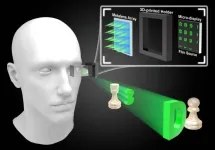NIL Metalens array enabling next-generation true-3D near-eye displays
2024-01-23
(Press-News.org)
Integral imaging (II) display is one of the most promising near-eye displays (NEDs) due to its compact volume, full parallax, convenient full-color display, and, more importantly, true-3D and more realistic depth perception from eliminating the vergence-accommodation conflict (VAC). However, II displays based on the conventional optical architecture, such as microlens arrays, are limited in resolution, field of view, depth of field, etc. As micro-displays have increasingly higher pixel densities, conventional optical architecture is inadequate in pixel-level light manipulation. Meta-optics has the potential to break through these bottlenecks with its unprecedented flexibility in pixel-level light manipulation by a monolithic device. Meta-II display is expected to be a big step towards next-generation virtual reality (VR) and augmented reality (AR) by creating more immersive experiences.
However, some challenges must be overcome before the meta-II display can become mainstream in the field of NED. One challenge is that the metalens array, the critical component of a meta-II display, is too small to match commercial high-resolution micro-displays and their etendue due to the underdevelopment of large-area higher-precision nanofabrication technology. Another challenge is that the rendering is computationally expensive for high-resolution wearable NEDs because the elemental image array (EIA), the signal input into the meta-II display, must be calculated for every viewpoint and thus need GPUs to accelerate. Fortunately, recent advances in nanofabrication and II algorithms open the possibility of practical meta-II displays. The meta-II displays are expected to advance VR/AR displays as these challenges are overcome. They can revolutionize how people interact with these technologies and eventually become the standard for VR and AR displays.
In a new paper published in eLight, a team of scientists led by Professor Jian-Wen Dong and Zong Qin from Sun Yat-sen University created a novel true-3D technical architecture called meta-II NED, first achieving the combination of meta-optics and II displays to the practical application of NED.
The meta-II NED combines a commercial high-pixel-density micro-display and a large-area metalens array. The metalens array, with a minimum feature size of around 100 nm and a maximum nanostructure height of about 500 nm, is made of high-refractive-index nanoimprint glue and fabricated using high-precision large-area nanoimprint technology. Compared to electron beam lithography, nanoimprint technology can quickly replicate many metalens array samples, especially large-area samples. The low-cost, large-area nanoimprint fabrication process makes metalens arrays feasible for mass production. To match this convenient meta-II NED architecture, a new real-time rendering method was developed to quickly generate the EIA with an average frame rate of 67 FPS by exploiting the invariant voxel-pixel mapping. True-3D display was verified experimentally through monocular focus cues and motion parallaxes. A see-through effect of the meta-II NED module was realized by merging 3D images with surrounding objects, showing the broader potential of the meta-II display for AR.
The research team has pioneered the development of true-3D NED with a combination of meta-optics and II displays. Note that the design flexibility of metalens arrays is promising for next-generation NEDs regarding several long-standing issues in conventional II architectures. For example, extended depth of field is vital for true-3D NEDs to present images from the person space to the vista space, whereas the microlens array induces a very limited depth of field. In contrast, a metalens array can be easily designed as a polarization multiplexing element with varying focal lengths to allow depth of field extension. In addition, the meta-II architecture provides a promising solution to increase the FOV for further study: freeform phase profiles that precisely compensate for the field-dependent aberration of conventional microlens arrays can be recorded in a slim metalens array. More importantly, both extened-depth-of-field and FOV-expanded meta-II architectures suffer from no cost in computational complexity and system volume compared with the meta-II proposed above. In general, metalens arrays are enabling next-generation true-3D near-eye displays.
END
[Attachments] See images for this press release:


ELSE PRESS RELEASES FROM THIS DATE:
2024-01-23
A UC San Francisco-led study has for the first time identified genetic variants that predict whether patients will respond to treatment for preterm birth, a condition that affects one in 10 infants born in the United States.
The findings are critical because no medication is available in the U.S. to treat preterm birth. Last year, the Food and Drug Administration (FDA) pulled the only approved therapy to help prevent this condition, a synthetic form of progesterone sold under the brand name Makena, from the market, citing ineffectiveness.
The new research found that pregnant individuals with high levels of mutations in certain genes ...
2024-01-23
People suffering from Long COVID or Myalgic Encephalomyelitis /Chronic Fatigue Syndrome (ME/CFS) could benefit from a coordinated treatment strategy, a new University of Otago study has found.
The pilot study, published in Scientific Reports, a Nature journal, has confirmed what researchers have suspected for some time: the two conditions are closely related.
Lead author Emeritus Professor Warren Tate says the research - the first comparative molecular study of the immune cell proteins of both conditions - “strongly affirms” the link between the two.
“This means information from study of the pathophysiology ...
2024-01-23
Now in its third year of operation, Direct to Open (D2O) is proud to announce that it has reached its full funding goal in 2024 and will open access to 79 new monographs and edited book collections this year. What makes this year noteworthy is that this is the first year in which D2O has been fully funded by its November 30 deadline and will not require an extension through the end of the fiscal year.
“Reaching our overall funding goal – in full and on time – is a major milestone in developing a sustainable open ...
2024-01-23
Attending an NHS Health Check appointment — a preventative screening programme offered for free in the UK — is associated with both a decreased risk of dying and a decreased risk of several diseases, including dementia and liver cirrhosis. The results, published in BMC Medicine, suggest that the NHS Health Check and other similar preventative programmes can be effective at reducing a population’s overall risk of long-term disease.
The NHS Health Check is a preventative screening programme designed to identify individuals at risk for heart disease, stroke, diabetes, and kidney disease. Healthy ...
2024-01-23
Knocking back energy drinks is linked to poor quality sleep and insomnia among college students, finds a large Norwegian study published in the open access journal BMJ Open.
And the higher the frequency of consumption, the fewer hours of nightly shut eye the students clocked up. But even just the occasional can—1-3 times a month—is linked to a heightened risk of disturbed sleep, the findings indicate.
Energy drinks contain an average caffeine content of 150 mg per litre as well as sugar, vitamins, minerals and amino acids in varying quantities, note the researchers. Marketed as mental and physical pick-me-ups, ...
2024-01-23
Men with inflammatory joint disease, such as rheumatoid arthritis, are less likely to be childless and have more children than their healthy peers, suggests research published online in the Annals of the Rheumatic Diseases.
As yet unknown factors associated with developing the disease and/or its treatment might influence fertility, suggest the researchers.
Autoimmune diseases are on the rise in the West, and impaired fertility has been reported in Norwegian women with inflammatory joint diseases. But only a few studies looking at the potential impact on men’s fertility have ...
2024-01-23
The fastest and highest growth in the prevalence of childhood obesity in England has been among 11-15 year olds, rising from 30% in 1995 to 38% in 2019, finds a detailed analysis of national data, published online in the Archives of Disease in Childhood.
But the inequality gap in rates has deepened, driven primarily by differences in deprivation, gender, family structure, ethnicity and parental education, the analysis reveals.
And the current cost of living crisis is set to aggravate these disparities, putting even more disadvantaged children at risk, warn the study authors.
England is projected to have the highest prevalence of obesity in ...
2024-01-23
TORONTO – An international research team led by Krembil Brain Institute Neurologist and Senior Scientist, Dr. Anthony Lang, has proposed a new model for classifying Parkinson’s disease (PD).
In recent decades, researchers have uncovered several biological factors that underlie PD. Key factors include a build up of the protein α-synuclein in the brain, which leads to neuron degeneration, and genetic factors that increase one’s risk of developing the disease. They have also begun to develop reliable methods to test for these factors, called biomarkers, in living patients.
Despite these advancements, ...
2024-01-23
A team of international researchers, led by UC San Francisco, has completed the first large-scale study of posterior cortical atrophy, a baffling constellation of visuospatial symptoms that present as the first symptoms of Alzheimer’s disease. These symptoms occur in up to 10% of cases of Alzheimer’s disease.
The study includes data from more than 1,000 patients at 36 sites in 16 countries. It publishes in the Lancet Neurology on Jan. 22, 2024.
Posterior cortical atrophy (PCA) overwhelmingly ...
2024-01-23
The importance of moth caterpillars for common garden birds has been revealed in a new study.
Researchers found that years when moth numbers were up resulted in increased population growth for the blue tit.
The results, derived from 23 years worth of bird and insect population data, are published today (Tuesday, 23 January) in Ecology Letters.
Dr Luke Evans, of the University of Reading, led the research. He said: "Insect abundance directly impacts songbird numbers from year to year. When moth caterpillars are large in number, blue tit parents can easily find food for their demanding chicks. When moth numbers crash it gets much harder for birds to find enough insects and raise ...
LAST 30 PRESS RELEASES:
[Press-News.org] NIL Metalens array enabling next-generation true-3D near-eye displays




